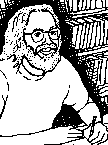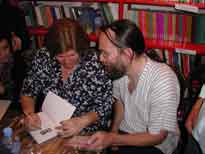
 |
Marc Becker sits with Aleida Guevara, Che Guevara's daughter. |
Motorcycle Diaries follows Che's early years
Marc Becker
The Monitor
October
26, 2004
“Be like Che,” school kids in Cuba are told. The “Che” they are supposed to emulate is the famed revolutionary leader and heroic guerrilla leader Ernesto “Che” Guevara. Rather than that mature, unselfish, internationalist who fought for a socialist revolution in Cuba, the Congo, and Bolivia, this film is a coming of age tale of a 23-year-old medical student who leaves the comfort of his middle-class existence in Buenos Aires. It is the story of Che before he became Che.
The Motorcycle Diaries chronicles Che’s second of three forays toward a discovery of Latin America. The first trip in 1950 took him to northern Argentina where he observed first-hand the depths of poverty that plagued the region. The third trip in 1953 led him to witness the aftermath of the 1952 MNR revolution in Bolivia and the fall of the leftist Jacobo Arbenz government in Guatemala in 1954. Those events politicized him to the point where in 1956 he joined Fidel Castro’s guerrilla war against the Batista dictatorship in Cuba.
On this second trip in 1951-1952, Che traveled with his friend Alberto Granado on a motorcycle nicknamed “La Poderosa” (“The Powerful One”). Within a year of finishing medical school, the future revolutionary is a college dropout looking for adventure. This film is based on Che’s diary as they journeyed from Argentina in the southern part of the continent through Chile, Peru, Colombia, and finally ending at Venezuela in the north. The film is perhaps mistitled because after crashing the overloaded bike as many as nine times in one day it finally gave up the ghost in Chile, only about a third of the way into the trip. From there, the chronically broke friends hitched rides on the back of trucks and bummed food and shelter off of friendly souls they met along the way. This, however, also put them in much more intimate contact with their surroundings.
Movies often pale in comparison to their written counterparts, but this film does justice to Che’s published diary. Che was a an avid amateur photographer, and the film excels at recreating these images as it takes us on a tour of the stunning Andean landscape. More importantly, it captures the personal characteristics that made Che a heroic guerrilla leader.
The film ends with Che leaving Caracas, Venezuela as a passenger on a cargo plane. He has discovered a very diverse continent, but proclaims that its destiny is intimately linked together in a pan-Latin American identity. The film projects Che forward to his key leadership role in the triumph of the Cuban Revolution eight years later and then to his death at the hands of the CIA in Bolivia in 1967.
Although this film presents a “pre-political” Che, it also reveals the roots of his ideology in formation. As he visits a mining camp and leper colony, the poverty and injustices radicalize him. It awakens a desire to end oppression, exploitation, and class divisions. Che was a very demanding man, but he demanded more of himself than he did of others. He did not let his asthma or other roadblocks stop him from realizing his goals. That passion and drive is what makes him a model for Cuban school children, as well as a hero for idealists throughout the world.